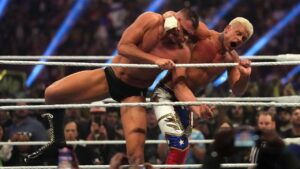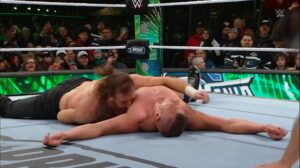Much like another late 80’s WWF Superstar, Koko B. Ware has become a meme or stock response to many wrestling discussions. But while Marty Jannetty takes the crown of the name used as an example of the least successful member of a tag team (as in “Chris Harris is the Marty Jannetty of America’s Most Wanted”), Koko B. Ware’s name is always brought up whenever a suspect choice is made for induction into the WWE Hall of Fame (or when fans online debate whether guys like Santino Marella or Eugene should be inducted): “They’ll let Koko B. Ware in, so anyone can go in.” And while it elicits a good chuckle, he’s actually a pretty unfair victim for the analogy.
THERE’S WORSE INDUCTEES

First off, there have been far worse inductees brought into the WWE Hall of Fame. But unless you’re over 50 or don’t follow wrestling history pre-Attitude Era, you probably don’t realize it. You’ve had it so ingrained in your head since internet puberty that Koko B. Ware is the…well…Koko B. Ware of Hall of Fame inductions – and based purely on his stint with the WWF in the late 80’s – that you’ve most likely just taken the statement as gospel and not dug through James Ware’s wrestling career. Take for example, Johnny Rodz or Baron Mikel Scicluna. Both men were part of Vincent J. McMahon Sr.’s WWWF (the precursor to his son Vince Jr.’s WWF) and were part of the company for decades. In fact, both were early purges by Vince Jr., outdated throwbacks to the days of rasslin’ – and we all know how Vinnie Mac feels about rasslin’. But both men were low midcarders (or high low carders, depending who you ask) who were primarily enhancement talent (“jobbers”) whose main claim to fame was lasting so long and winning so little. Both of those men are far worse inductions than Koko B. Ware. But those names are probably foreign word scrambles if you started watching wrestling during the Monday Night Wars. Koko B. Ware still had residue from the 80’s and in the 90’s, everything about the 80’s was looked at with veritable disdain.
BUT ONLY HIS WWE YEARS COUNT

Secondly, whenever someone brings up Koko B. Ware’s career prior to the WWF, the inevitable response of “But it’s the WWE Hall of Fame, so only his WWF career counts” always rears it’s ugly head, and usually with a tone of smugness like they’d just dropped Little Boy into the party. But the membership of the WWE Hall of Fame shows that is quite clearly not the case. Ric Flair‘s WWE career was memorable, but not Hall of Fame worthy alone. The main reasoning of his induction was his masterful work in the NWA and most of his WCW run. His WWE career is just Vince McMahon’s icing on someone else’s cake. Ricky Steamboat‘s WWF career gave us that match, but the rest of it was pretty forgettable. What wasn’t unforgettable was his rivalry with Ric Flair that rocked Mid-Atlantic and WCW. The same detractors scream that Vader should be in the WWE Hall of Fame (spoiler: he should be), but his WWF career was arguably worse than Koko B. Ware’s. He was a huge name, sure, but his booking was atrocious. The meat of his buffet table was built in Japan as IWGP Heavyweight Champion with NJPW and in WCW as the WCW World Heavyweight Champion. Jobbing out to Marc Mero and Val Venis in 1998 does not a Hall of Fame career make. And do you seriously think Dory Funk Jr. is in it for his Hoss Funk gimmick, or that Terry Funk is in it for Chainsaw Charlie? Or that Dusty Rhodes is in it for the polka dots or Harley Race is in it for being the first King of the WWF? And if only the WWF career counts is your stance, then apparently Sting being inducted into the Hall of Fame for losing two career matches is more of an accomplishment than being in this video (spoiler: it isn’t).
https://www.youtube.com/watch?v=wZfMsBitPIQ
SO TELL ME MORE ABOUT KOKO B. WARE THEN
Clearly the WWE is inducting great workers from lots of promotions that aren’t theirs, such as AWA Legends Verne Gagne or Nick Bockwinkel, NJPW’s Antonio Inoki and Tatsumi Fujinami, and NWA and early pre-WWWF stars like Lou Thesz, Gorgeous George and Mildred Burke. So where did the WWF Superstar known as “The Birdman” come from? As goofy as he looked, he was not a WWF homegrown talent. Much like most of his 80’s roster, Koko B. Ware was another territory’s top talent that Vince McMahon simply offered better money to and better guarantees of international exposure – something McMahon provided tenfold.

He began wrestling in 1978 as Koko Ware, working around in the southern territories, principally consisted of Jerry Jarrett’s Continental Wrestling Association in Memphis and in NWA Mid-America. In 1977, Jarrett and Jerry Lawler left NWA Mid-America and started the CWA. By 1981, the CWA won the wars in Memphis and acquired NWA Mid-America, then merged with Fritz Von Erich’s WCCW in 1989 to become the United States Wrestling Association (USWA). Memphis wrestling was where Ware was raised, as well as Nashville and other stops around his home state. It wasn’t until a few years in that his star began to take off (despite being named 1979’s Rookie of the Year by Pro Wrestling Illustrated), but he was still main eventing cards during a time in Tennessee where Jerry Lawler was King.

KOKO B. WARE AND MEMPHIS GOLD

He spent some early time in the CWA as Sweet Brown Sugar, part of “The Mouth of the South” Jimmy Hart’s First Family of Wrestling, a large stable of top Southern stars such Randy Savage, King Kong Bundy, Rick Rude, Kamala, Jim “The Anvil” Neidhart and The Blonde Bombers (featuring a pre-Elvis Honky Tonk Man), all based around 10x NWA Mid-America Champion Bobby Eaton (pre-Midnight Express). And as Sweet Sugar Brown, he was a 2x AWA Southern Tag Team Champion (CWA allied with the AWA rather than the NWA) alongside Bobby Eaton in some epic battles against the original Midnight Express (Dennis Condrey, Austin Novell and Randy Rose), before Eaton would end up joining the iconic tag team, as well as battles with the legendary Fabulous Ones (Stan Lane & Steve Keirn). In 1980, he tasted his first singles gold, winning the NWA Mid-America Television Championship, and feuding with Dutch Mantel.

He was then put under a mask and wrestled as Stagger Lee, before being unmasked and turning heel, returning to his original moniker Koko Ware. He was paired with his former foe from the Midnight Express, Austin Novell, in a Michael Jackson-themed gimmick, The Pretty Young Things (and later The PYT Express), and joined another stable, this time Pringle’s Dynasty, lead by famed Southern manager Percy Pringle (more commonly known as Paul Bearer). They would become 3x AWA Southern Tag Team Champions.

And while perhaps his seven reigns as AWA Southern Tag Team Championships may not seem important, these were titles that were held by some of the top tag teams of the day – The Fabulous Freebirds, The Rock N’ Roll Express, The Midnight Express, and The Fabulous Ones amongst others – and he was winning them amidst that mix. But his singles hardware didn’t stop at the TV title. James Ware was also a 6x NWA Mid-America Heavyweight Champion, the top singles title in the territory – and he did it with all three gimmicks. As Sweet Brown Sugar he won the title from his former partner, Bobby Eaton, and then won it back as the masked Stagger Lee. He won his third from “Nature Boy” Buddy Landell (unmasking as Koko Ware during the reign). By the end of his run in Tennessee, he’d just feuded with Harley Race over the same title. He jumped to Mid-South where he gained the middle initial “B” and feuded with Buzz Sawyer, Rick Steiner, and Dick Slater amongst others. He was fast and athletic, but he could work stiff if needed be.
https://www.youtube.com/watch?v=7sTqKA1_-XI
THE BIRDMAN IN THE WWF

Koko B. Ware joined the WWF in 1986 and had an eight year run with the company – he headed back to Memphis to rejoin Lawler in the USWA during a talent exchange and alliance between the WWF and USWA. Ware captured the USWA Unified World Heavyweight title twice (it had since been merged with the AWA and WCCW World Championship), once from Memphis icon Jerry “The King” Lawler.

But ultimately it’s his career in the WWF that most people remember him by. In the days of WWF’s Rock N’ Wrestling, people forget that what now looks alarmingly cheesy was actually incredibly popular. Koko B. Ware was never the guy in the WWF, but he was one of the mid-cards most popular entertainers, even if he did seem to be an early victim of Vince’s 50/50 booking. And while many may spotlight the fact he never won the Intercontinental title during his 8-year WWF run, it would have been hard to do when you have guys like Randy Savage (414 days), Honky Tonk Man (454 days), Rick Rude (148), Ultimate Warrior (216), Mr. Perfect (406), Bret Hart (290), Shawn Michaels (315) and Razor Ramon (438) to contend with in that era.
But he was a constant team player, the kids loved him, and he brought an athleticism to the WWF that was rarely displayed by Titan Sports. When the WWF brought in Owen Hart the second time around, they were briefly paired together as High Energy in an attempt to help bolster Owen’s presence. And while many point at that moment as one of the negative reasons for his Hall of Fame induction, High Energy only lasted a few months total (Owen got injured). It was but a snicker in a pretty solid career. Shortly after his run with USWA, he retired in 1995.

KOKO B. WARE: HALL OF FAMER

People need to realize that the WWE Hall of Fame is more akin to the Hollywood Walk of Fame than the Pro Football Hall of Fame. It’s a loose knit set of criteria at best, but designed to commemorate all those who have paved the way for the industry, and left a memorable mark in the minds of fans and peers alike. After all, not every person on the Hollywood Walk of Fame were Oscar winners, or even contenders. Some were merely character actors who appreciated their craft and their audience and deserved to be recognized for what they did bring to the table, not just the just deserts they received upon getting to it. Everyone in the WWE Hall of Fame – hell, in any sports or entertainment shrine – should not be equal stars. Because it wasn’t just the stars that built the sport, or the industry, or the WWF, or pro wrestling itself. It needed its Hulk Hogan’s and Bruno Sammartino’s and Ric Flair’s, but it also needed its Johnny Rodz, Baron Mikel Scicluna and Koko B. Ware’s. The men and women that helped make the Superstars look Super. The men and women who put smiles on children’s faces, inspired children of all shapes, sizes and colours to become pro wrestlers. And Koko B. Ware was one of those people.
Are there lots of other wrestlers that deserve to be in there that aren’t? Of course there are. But to paraphrase an interview Bruce Pritchard gave years ago in regards to how each year’s class is assembled, think of each class as a wrestling card. Every year they start with a main event. If we’re lucky we’ll get co-main events. Then there’s a tag team match. A women’s match. And in between there are matches featuring mid-carders and there are matches featuring low carders. They all put in their time. They all deserved to be remembered by future generations if they left a mark.
And Koko B. Ware left a mark. In the history of Memphis wrestling, in the rise of African-American wrestlers in professional wrestling in the 1970’s, and in the story of the WWF’s rise to dominance in the 1980’s.






